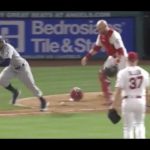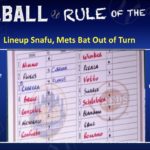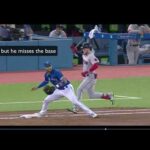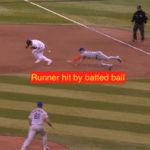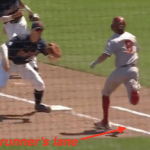NCAA 7-11 When Batter or Batter-Runner Is Out
When Batter or Batter-Runner Is Out
SECTION 11. A batter is out when:
a. On appeal by the opposing team, the individual fails to bat in the proper turn and another batter completes a time at bat in that place;
1) The proper batter may replace the improper batter before the batter becomes a runner or is put out, and any balls and strikes shall be counted against the proper batter.
2) If the improper batter becomes a base runner or is put out and an appeal is made to the umpire-in-chief before a pitch to the next batter of either team, or a play or attempted play, the proper batter is declared out and all runners return to bases held before action by the improper batter. However, any advances by a runner(s), (e.g., stolen base, balk, wild pitch, passed ball) while the improper batter is at bat are legal. If the proper batter is declared out, the next person in the lineup shall be the batter.
3) If a proper appeal is not made, the improper batter becomes the proper batter and the results of the time at bat become official.
4) When the action of the improper batter becomes official, the batting order resumes with the following batter.
5) If the defensive team has ignored an improper batter who now is on base when the “official” turn at bat arrives, the individual shall be passed over and the next person in the lineup shall be the proper batter.
Note: The umpires, official scorer or public-address announcer shall not call attention to the improper batter. If this occurs, the umpire-in-chief shall warn the official scorer and/or the public-address announcer that on the next infraction the offending person will be removed from the position.
b. After a third strike not caught or after the player hits a fair ball, the individual or first base is tagged before reaching that base;
c. The individual hits a fair or foul fly other than a foul tip, and the ball is caught legally by a fielder;
d. The individual bats the ball illegally (see 1-12-b PENALTY);
e. The individual steps from one batter’s box to the other while the pitcher is in position ready to pitch;
f. The batter intentionally or unintentionally interferes with the catcher’s fielding or throwing by stepping out of the batter’s box or making any other movement that hinders a defensive player’s action at home plate;
PENALTY for f.—The batter is out and all runners return to their bases at the time of the pitch.
Exceptions—
1) If the runner is advancing to home plate and there are fewer than two outs, the runner, instead of the batter, is out.
2) The batter is not out if any runner attempting to advance is put out, or if the runner trying to score is called out for batter’s interference.
3) If the batter also should strike out on the play, it is a double play.
4) If a batter/runner and a catcher fielding the ball make contact, no call shall be made unless either player intentionally interferes with the play.
Note: A batter’s actions must be intentional for there to be interference during a catcher’s return throw to the pitcher. If it is unintentional and the return throw to the pitcher hits the batter or his bat while he is in the batter’s box, the ball remains live and in play. If the batter does nothing intentional and no runners are attempting to advance, and the catcher’s return throw to the pitcher hits the batter or his bat while he is legally out of the batter’s box, it is not interference. The ball is immediately dead and all runners return without penalty.
g. A third strike legally is caught by the catcher (see Rule 2—Foul Tip);
h. A third strike is not caught, provided a runner occupies first base and there is not more than one out;
Note: If, while attempting to advance to first base, the batter-runner intentionally deflects the ball, the batter-runner is declared out, the ball is dead and all runners return. If, the batter-runner unintentionally deflects the ball with 2 outs, the ball is alive and in play. With less than 2 outs and first base occupied, the ball is dead and all runners return, unless the runner(s) are stealing on the pitch.
i. A bunt on the third strike is a foul ball;
j. An infield fly is declared (see Rule 2—Infield Fly);
k. The individual attempts to hit a third strike and is touched by the ball (the ball is dead);
l. A batted fair ball touches the batter-runner outside of the batter’s box before touching a fielder;
m. After hitting or bunting a fair ball, a bat still in the batter’s hand(s) hits the ball a second time in fair territory after he has left the batter’s box. The ball is dead and no runners may advance. If the batter-runner drops the bat and the ball rolls against the bat in fair territory and there was no intent to interfere with the course of the ball, the ball is live and in play;
n. A whole bat is thrown into fair territory, whether intentionally or not, and it interferes with a defensive player attempting to make a play. Interference shall be called;
Note: It is not interference and the ball remains in play if the bat breaks and a part of it is hit by the batted ball in fair territory or a part of it hits a runner or a fielder. If a part of this bat or a whole bat is touched by the batted ball in foul territory, it is a foul ball;
o. After hitting or bunting a foul ball, the batter-runner intentionally deflects the course of the ball that has a chance of becoming fair; or intentionally interferes with the catcher’s attempt to field a third strike. The ball is dead, the batter is out and no runner may advance;
p. In running the last half of the distance from home plate to first base while the ball is being fielded to first base, the batter-runner runs outside the 3-foot restraining line or inside the foul line and, in so doing, interferes with the fielder taking the throw at first base, except that the batter may go outside these lines to avoid a fielder attempting to field a batted ball;
Note 1: If the batter-runner is running illegally to first base and his being outside the lane alters the throw of a fielder, hinders or alters a fielder’s opportunity to field the throw, or the batter-runner is hit by the throw that has been made in an attempt to make a play, it shall be called interference and the batter-runner is to be called out.
Exception—The batter-runner is permitted to exit the three-foot running lane by means of a step, stride, reach or slide in the immediate vicinity of first base and for the sole purpose of touching first or attempting to avoid a tag. He may exit the running lane on his last stride or step if he has been running legally within the running lane up to that point.
Note 2: The batter-runner is considered outside this 3-foot lane if either foot is outside either line.
Note 3: On a tag play between home plate and first base, a batter-runner may retreat toward home plate to evade a tag, but shall be declared out after touching or passing home plate, or leaving the base line. The ball remains live.
q. With fewer than two outs and first, first and second, first and third or first, second and third bases occupied, an infielder intentionally drops a batted or bunted fair fly ball or line drive. The ball is dead, and the runner or runners shall return to their original base or bases;
Note: The batter is not out if the ball drops untouched to the ground, except when the infield fly rule applies. If a declared infield fly is dropped intentionally or allowed to fall untouched, the batter is out, the ball is live and in play, and the runners may advance at their own risk. They do not need to retouch their bases.
r. In a force situation, a preceding runner intentionally interferes with the play of a fielder who is attempting to catch a thrown ball or to throw the ball in an attempt to complete any play (see 8-5-d);
s. With two outs, a runner on third base and two strikes on the batter, the runner attempts to steal home plate on a legal pitch and the ball hits the runner in the batter’s strike zone. The umpire shall call “Strike three”; the batter is out; the run shall not count. With fewer than two outs, the umpire shall call “Strike three”; the ball is dead; the run counts. All other runners return to the base(s) occupied at the time of the pitch unless they were stealing with the pitch;
t. Spectator interference clearly prevents a fielder from catching a fly ball, if inside the playing field;
u. A batter who does not realize his situation on a third strike not caught and who is not in the process of running to first base, shall be declared out once he leaves the dirt circle surrounding home plate heading toward his dugout; or
v. If the batter hits, or attempts to hit, a throw made to home plate by the pitcher who is not in contact with the pitching rubber, and is attempting to retire a runner stealing home, interference shall be called and the ball is dead.
PENALTY for v.—With two outs, the batter is out. With fewer than two outs, the runner shall be out.

